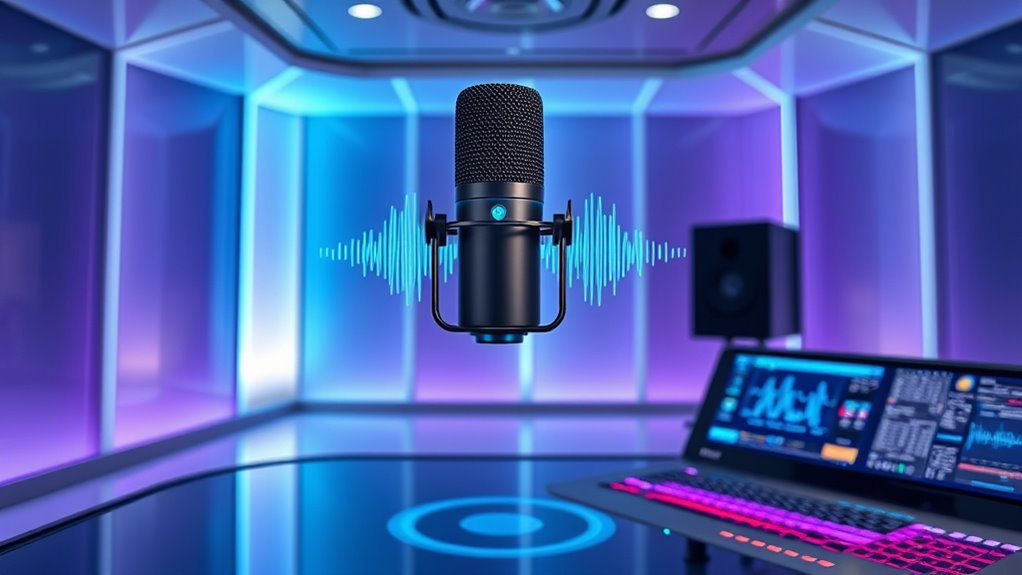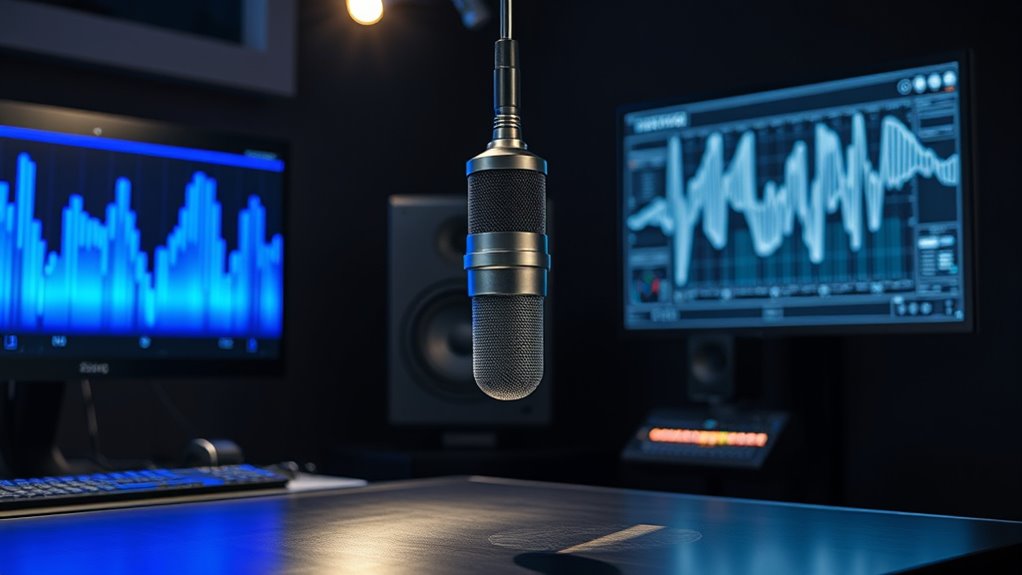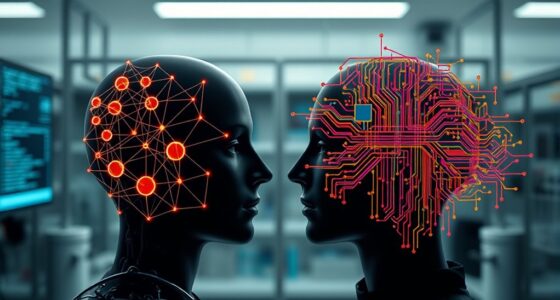Advances in neural network-driven voice synthesis now let you craft highly realistic, expressive synthetic voices that sound nearly human. These systems analyze large datasets to mimic natural speech patterns, including emotion and nuance, reducing the uncanny valley effect. As a result, your synthetic voices become more authentic, engaging, and seamless. If you keep exploring, you’ll discover how these innovations are transforming industries and creating even more convincing virtual audio experiences.
Key Takeaways
- Neural networks analyze large voice datasets to generate natural, expressive synthetic voices that resemble real human speech.
- Advances in neural voice synthesis reduce robotic tone and awkward pauses, minimizing the uncanny valley effect.
- Fine-tuning and adaptive learning enable creation of unique, authentic voices with nuanced pitch, rhythm, and emotion.
- Continuous improvements in technology make synthetic voices increasingly indistinguishable from real ones.
- These innovations enhance virtual assistants, audiobooks, and avatars with more natural and emotionally resonant audio.

Have you ever wondered how computers can create music and soundscapes that feel entirely new? It’s fascinating how technology now enables the generation of realistic, expressive voices without sounding synthetic or uncanny. At the core of this innovation is voice synthesis, a process that transforms digital signals into human-like speech. This isn’t just about making a robot talk; it’s about crafting voices that can convey emotion, nuance, and personality. You might think that creating such convincing synthetic voices is impossible without crossing into the uncanny valley, where voices sound eerily unnatural or unsettling. But recent advances have made this a thing of the past.
The secret lies in neural networks, a type of machine learning model inspired by the human brain. These networks analyze vast amounts of voice data, learning patterns, intonations, and speech dynamics. Once trained, they can generate speech that’s remarkably close to natural human voices. Instead of relying on traditional, rule-based systems, neural networks adapt and improve through exposure to diverse voice samples. This flexibility allows for more expressive and varied speech synthesis, which is *fundamental* for applications like virtual assistants, audiobooks, and even personalized voice avatars.
What makes neural network-driven voice synthesis so impressive is its ability to produce smooth, continuous speech that retains emotional context. It can mimic the subtle rise and fall of pitch, the rhythm of speech, and the unique qualities of individual voices. This means you can have a synthetic voice that not only sounds human but also feels authentic and relatable. Developers can fine-tune these systems to match specific voices or create entirely new ones, opening up a world of creative possibilities.
Additionally, neural networks help overcome traditional limitations such as robotic intonation or awkward pauses. They learn to generate speech that flows naturally, reducing the risk of the uncanny valley effect. The technology is becoming so refined that listeners often cannot distinguish between authentic human speech and synthetic voices. This progress is transforming industries, making virtual interactions more personal and engaging.
Furthermore, advancements in voice synthesis technology are continuously pushing the boundaries of what’s possible, making synthetic voices more nuanced and expressive than ever before. This progress is revolutionizing industries, making virtual interactions more personal and engaging.
In essence, neural networks revolutionize voice synthesis by enabling the creation of rich, expressive, and natural-sounding voices. You no longer have to settle for robotic chatter; instead, you get voices that feel genuine and human, all without falling into the uncanny valley. As this technology continues to evolve, it promises even more immersive and emotionally resonant audio experiences—proof that the line between real and synthetic voice is rapidly blurring.
Frequently Asked Questions
How Does Generative Audio Differ From Traditional Voice Synthesis?
You notice that generative audio differs from traditional voice synthesis by producing more natural-sounding voices. It uses advanced algorithms to improve voice naturalness, reducing robotic or uncanny qualities. Unlike traditional methods, which rely on predefined templates, generative audio offers greater synthesis variability, creating diverse voices and expressions. This approach allows for more authentic interactions, making synthetic voices feel more human and engaging, enhancing user experience markedly.
What Are the Main Challenges in Avoiding the Uncanny Valley?
You face challenges in avoiding the uncanny valley because human perception is highly sensitive to subtle cues that reveal artificiality. Achieving realistic textures in synthetic voices is essential, but small imperfections can trigger discomfort or suspicion. You need to refine these textures continuously, balancing naturalness with technological limits. Ultimately, your goal is to create voices that seamlessly blend into human interaction without falling into the uncanny valley, ensuring authenticity and acceptance.
Can Generative Audio Replicate Emotional Nuances in Voices?
It’s ironic, isn’t it? You’d think replicating genuine emotion in synthetic voices is straightforward, yet emotional authenticity remains elusive. You can mimic tone and pitch, but capturing nuance preservation is tricky. While technology advances, synthetic voices often lack true emotional depth, making them sound flat or hollow. So, even with sophisticated algorithms, recreating authentic emotional nuances still challenges creators seeking truly human-like expression.
What Ethical Concerns Arise With Synthetic Voice Generation?
You should consider that synthetic voice generation raises significant ethical concerns, especially around privacy risks and consent issues. When you create or use synthetic voices, there’s a danger of misusing someone’s identity or personal data without permission. This can lead to privacy breaches and manipulation. It’s vital to guarantee transparent consent processes and safeguard individuals’ rights to prevent misuse and maintain trust in this rapidly advancing technology.
How Accessible Is Generative Audio Technology for Creators?
You’ll find that generative audio technology is becoming increasingly accessible for creators, thanks to user-friendly tools and platforms. These advancements improve audio accessibility, enabling you to produce high-quality synthetic voices without extensive technical skills. Many creator tools now offer intuitive interfaces, making it easier to experiment and innovate. As a result, you can incorporate synthetic voices into your projects more seamlessly, expanding your creative possibilities and reaching wider audiences.
Conclusion
Imagine your voice as a brushstroke on a vast canvas—generative audio is the master artist, blending shades of reality and fantasy. As technology advances, you’ll find synthetic voices becoming more lifelike, closing the gap with genuine human expression. This evolution is like watching a sunrise—gradual yet inevitable—transforming how we create, communicate, and connect. Embrace this journey, knowing that soon, the lines between real and artificial voices will blur into a seamless, vibrant masterpiece.









